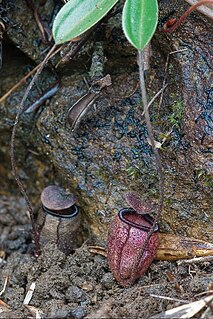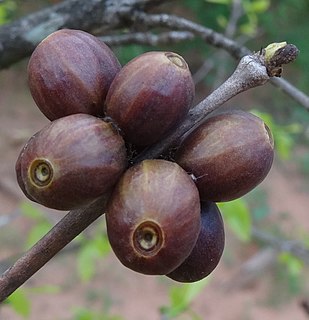
Myrica is a genus of about 35–50 species of small trees and shrubs in the family Myricaceae, order Fagales. The genus has a wide distribution, including Africa, Asia, Europe, North America and South America, and missing only from Australia. Some botanists split the genus into two genera on the basis of the catkin and fruit structure, restricting Myrica to a few species, and treating the others in Morella.

Chamaerops is a genus of flowering plants in the family Arecaceae. The only currently fully accepted species is Chamaerops humilis, variously called European fan palm or the Mediterranean dwarf palm. It is one of the most cold-hardy palms and is used in landscaping in temperate climates.
A rare species is a group of organisms that are very uncommon, scarce, or infrequently encountered. This designation may be applied to either a plant or animal taxon, and is distinct from the term endangered or threatened. Designation of a rare species may be made by an official body, such as a national government, state, or province. The term more commonly appears without reference to specific criteria. The IUCN does not normally make such designations, but may use the term in scientific discussion.

Cupaniopsis is a genus of about 67 species of trees and shrubs of the soapberry family, Sapindaceae. They grow naturally in New Guinea, New Caledonia, Australia, Torres Strait Islands, Fiji, Samoa, Sulawesi, Micronesia. Many species have been threatened with extinction globally or nationally, with official recognition by the International Union for Conservation of Nature (IUCN) and several national and state governments.

Nepenthes argentii is a highland Nepenthes pitcher plant native to Mount Guiting-Guiting on Sibuyan Island in the Philippines. It is possibly the smallest species in the genus and does not appear to have a climbing stage.

Elattostachys is a genus of about 21 species of trees known to science, constituting part of the plant family Sapindaceae.
Clinosperma macrocarpa is a species of palm tree known from a single population at around 500 metres (1,600 ft) altitude on Mont Panié, New Caledonia. It was described as the only species in the genus Lavoixia, but has since been moved to genus Clinosperma. It is listed as critically endangered on the IUCN Red List.
Saribus jeanneneyi is a very rare species of palm tree in the genus Saribus. It is endemic to southern New Caledonia, where only one mature specimen, surrounded by a few seedlings, survives in its native habitat. The cause of its rarity in the wild is because its meristem is edible.
Helicia polyosmoides is a species of plant in the family Proteaceae. It is endemic to Papua New Guinea. It is threatened by habitat loss. This taxon was described by Don Foreman in 1985.
Pancheria multijuga is a species of shrub in the family Cunoniaceae. It is endemic to New Caledonia, where it is rare and found only on a few mountains.
Pancheria robusta is a species of shrub in the family Cunoniaceae. It is endemic to New Caledonia, where it is rare and found only on a few mountains.
Pittosporum brevispinum is a species of plant in the Pittosporaceae family. It is endemic to New Caledonia.
Pittosporum gatopense is a species of plant in the Pittosporaceae family. It is endemic to New Caledonia.
Planchonella pinifolia is a species of plant in the family Sapotaceae. It is endemic to New Caledonia.
Weinmannia ouaiemensis is a species of plant in the family Cunoniaceae. It is endemic to New Caledonia.

Myrica cerifera is a small evergreen tree or large shrub native to North and Central America and the Caribbean. Its common names include southern wax myrtle, southern bayberry, candleberry, bayberry tree, and tallow shrub. It sees uses both in the garden and for candlemaking, as well as a medicinal plant.

Cyphokentia is a genus of flowering plant in the palm family endemic to New Caledonia. the genus is named from two Greek words meaning "tumor" and "Kentia", a former palm genus, and the species name translates to "large" and "spike", describing the inflorescence. The genus has two known species and Its closest relative is Clinosperma, also endemic to New Caledonia,. and sole other genus of subtribe Clinospermatinae.

The cave nectar bat, dawn bat, common dawn bat, common nectar bat or lesser dawn bat is a species of megabat within the genus Eonycteris. The scientific name of the species was first published by Dobson in 1871.

The southern giraffe, also known as two-horned giraffe, is a proposed species of giraffe native to Southern Africa. However, the IUCN currently recognizes only one species of giraffe with nine subspecies.

Coffea racemosa, also known as racemosa coffee and Inhambane coffee, is a species of flowering plant in the family Rubiaceae. It has naturally low levels of caffeine, less than half of that found in Coffea arabica, and a quarter of that in Robusta coffee. It is endemic to the coastal forest belt between northern KwaZulu-Natal in South Africa and Zimbabwe, found in an area less than 150 km2 (58 sq mi) in size. It was widely cultivated by the Portuguese during the 1960-1970s in Mozambique, currently there are only two plantations at Ibo Island and in Hluhluwe, which remain.











